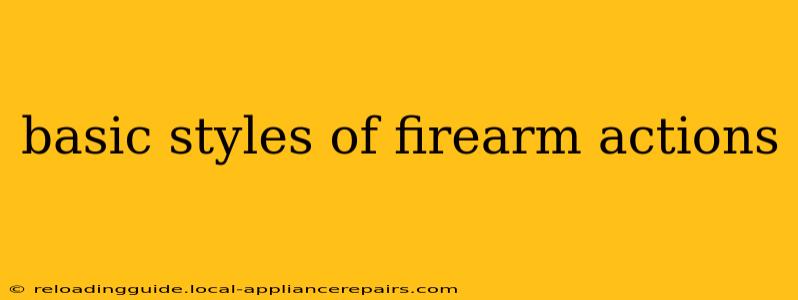Firearms, from simple pistols to complex rifles, rely on a variety of actions to load, fire, and eject cartridges. Understanding these actions is crucial for anyone interested in firearms, whether for sport shooting, hunting, or self-defense. This guide explores the basic styles of firearm actions, providing a detailed overview of their mechanisms and applications.
What is a Firearm Action?
Before diving into specific types, let's define what a firearm action is. The action is the mechanical system of a firearm that controls the loading, firing, and unloading of cartridges. It's the heart of the gun, responsible for the cyclical process that allows for repeated shots. Different actions offer varying levels of complexity, speed, accuracy, and reliability.
Major Firearm Action Types:
Here's a breakdown of the most common firearm action types:
1. Single-Shot Actions:
- Mechanism: The simplest type, single-shot actions require manual loading and unloading of each cartridge. After firing, the shooter must manually open the action, extract the spent casing, and load a new round.
- Features: Generally known for their simplicity, ruggedness, and accuracy. They're often found in hunting rifles and target pistols.
- Examples: Many bolt-action rifles, break-action shotguns, and some older handguns utilize this action.
2. Bolt-Action Actions:
- Mechanism: A bolt, containing the firing pin and extractor, slides back and forth to load, unload, and cock the firearm. The bolt is rotated to lock and unlock the action.
- Features: Known for their reliability, accuracy, and relatively smooth operation. Often preferred by hunters and precision shooters.
- Examples: Many hunting rifles, target rifles, and some military rifles use bolt-action mechanisms.
3. Lever-Action Actions:
- Mechanism: A lever located beneath the receiver is operated to load, unload, and cock the firearm. This action typically uses a tubular magazine.
- Features: Fast to operate, especially for repeat shots. Historically popular for hunting and sporting applications. However, the tubular magazine can limit the types of ammunition used.
- Examples: The Winchester lever-action rifles are a classic example.
4. Pump-Action Actions:
- Mechanism: A sliding forearm or "pump" is used to manually cycle the action, loading, firing, and ejecting cartridges.
- Features: Relatively simple, reliable, and often used in shotguns. Good for quick follow-up shots.
- Examples: Common in shotguns used for hunting, sport shooting, and home defense.
5. Semi-Automatic Actions:
- Mechanism: These actions use the energy from the fired cartridge to automatically cycle the action and load the next round. Requires a separate trigger pull for each shot.
- Features: Faster firing rate compared to manual actions, making them popular for self-defense and sporting competitions.
- Examples: Many modern handguns, rifles, and shotguns use semi-automatic actions. Different mechanisms within semi-automatic actions (blowback, gas-operated, recoil-operated) achieve this automatic cycling.
6. Fully Automatic Actions:
- Mechanism: These actions continuously fire as long as the trigger is held. Require significant legal restrictions to own.
- Features: Highest rate of fire, primarily used by military and law enforcement.
- Examples: Machine guns and submachine guns.
7. Revolver Actions:
- Mechanism: A revolving cylinder containing multiple cartridges rotates to align each cartridge with the barrel for firing.
- Features: Relatively simple design, and often favored for their ruggedness and reliability.
- Examples: Common in handguns, both single and double action.
Choosing the Right Action:
The best firearm action depends heavily on intended use. Hunters might prioritize accuracy and reliability, choosing a bolt-action rifle. Home defenders might favor the speed of a semi-automatic handgun or shotgun. Understanding the mechanics and characteristics of each action type is essential for making an informed decision. This guide provides a foundational understanding, and further research into specific firearms and their applications is always recommended.

